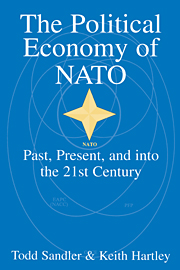Book contents
- Frontmatter
- Contents
- List of tables and figures
- Preface
- 1 NATO at the crossroads: An introduction
- 2 NATO burden sharing and related issues
- 3 On NATO expansion
- 4 NATO and peacekeeping
- 5 NATO and the defense industrial base: EU and USA
- 6 NATO challenges on the horizon
- 7 NATO and Europe
- 8 NATO design
- 9 Conclusions and future scenarios
- References
- Author index
- Subject index
2 - NATO burden sharing and related issues
Published online by Cambridge University Press: 05 June 2012
- Frontmatter
- Contents
- List of tables and figures
- Preface
- 1 NATO at the crossroads: An introduction
- 2 NATO burden sharing and related issues
- 3 On NATO expansion
- 4 NATO and peacekeeping
- 5 NATO and the defense industrial base: EU and USA
- 6 NATO challenges on the horizon
- 7 NATO and Europe
- 8 NATO design
- 9 Conclusions and future scenarios
- References
- Author index
- Subject index
Summary
NATO has remained a viable institution from its inception on 24 August 1949, when the North Atlantic Treaty entered into force. Many experts credit NATO with maintaining peace in Europe during the Cold War era and with helping to win the Cold War. For almost fifty years, NATO has endured and responded effectively to alterations in strategic doctrines, changes in economic conditions, advancements in weapon capabilities, and the emergence of political contingencies, while it has sought to deter Soviet aggression in Western Europe. With the end of the Cold War, the dissolution of the Warsaw Pact on 31 March 1991, and the withdrawal of Russian troops some 1,000 kilometers eastward, NATO no longer has the traditional role of deterring aggression from its eastern borders (Asmus, 1997; Bruce, 1995). Although the situation can always change, war with Russia is not a likely scenario these days. It is even less likely because of the downsizing of Russian forces and the severe economic problems challenging Russia today. Russia must allocate its resources to build up its economy if future political upheavals are to be avoided.
In the past, NATO has been an amazingly resilient institution that has grown in size from the original twelve members while it assumed additional chores. At the Madrid summit in July 1997, NATO agreed to accept the Czech Republic, Hungary, and Poland as new allies in 1999. The inclusion of these new allies could have profound political, strategic, and burden-sharing consequences (see Chapter 3).
- Type
- Chapter
- Information
- The Political Economy of NATOPast, Present and into the 21st Century, pp. 22 - 57Publisher: Cambridge University PressPrint publication year: 1999



